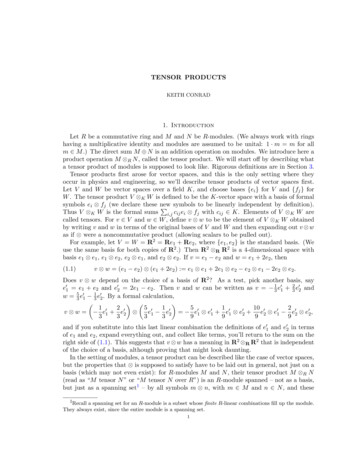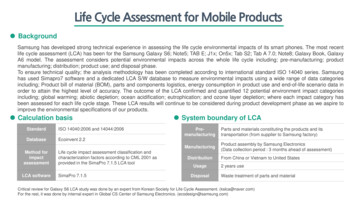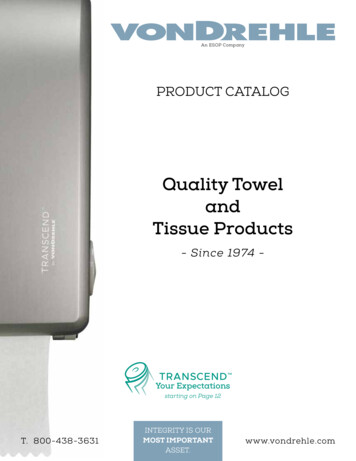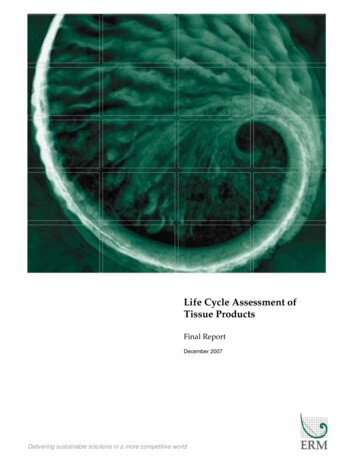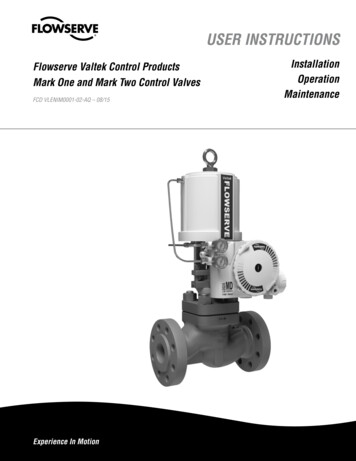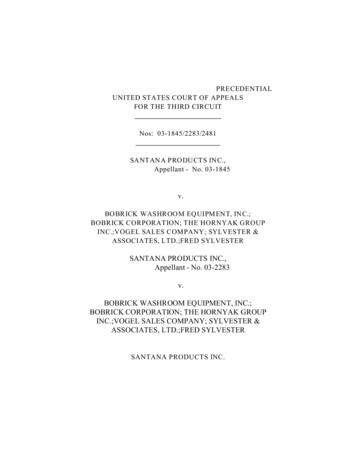
Transcription
PRECEDENTIALUNITED STATES COURT OF APPEALSFOR THE THIRD CIRCUITNos: 03-1845/2283/2481SANTANA PRODUCTS INC.,Appellant - No. 03-1845v.BOBRICK WASHROOM EQUIPMENT, INC.;BOBRICK CORPORATION; THE HORNYAK GROUPINC.;VOGEL SALES COMPANY; SYLVESTER &ASSOCIATES, LTD.;FRED SYLVESTERSANTANA PRODUCTS INC.,Appellant - No. 03-2283v.BOBRICK WASHROOM EQUIPMENT, INC.;BOBRICK CORPORATION; THE HORNYAK GROUPINC.;VOGEL SALES COMPANY; SYLVESTER &ASSOCIATES, LTD.;FRED SYLVESTERSANTANA PRODUCTS INC.
v.BOBRICK WASHROOM EQUIPMENT, INC.;BOBRICK CORPORATION; THE HORNYAK GROUPINC.;VOGEL SALES COMPANY; SYLVESTER &ASSOCIATES, LTD.;FRED SYLVESTERBOBRICK WASHROOM EQUIPMENT, INC.;BOBRICK CORPATION,Appellants - No: 03-2481Appeal from the United States District Courtfor the Middle District of Pennsylvania(D.C. No. 96-cv-01794 )District Judge: Thomas I. Vanaskie, Chief JudgeArgued March 23, 2004Before: ROTH, AMBRO and CHERTOFF, Circuit Judges(Opinion filed:February 9, 2005William E. Jackson, Esquire (Argued)B. Aaron Schulman, EsquireStites & Harbison1199 North Fairfax StreetTransPotomac Plaza, Suite 900)
Alexandria, VA 22314Gerald J. Butler, Esquire142 North Washington, Suite 800Scranton, PA 18503Counsel for AppellantsCarl W. Hittinger, Esquire (Argued)Stevens & Lee1818 Market Street, 29th FloorPhiladelphia, PA 19103Walter F. Casper, Jr., Esquire35 South Church Street & &th AvenueCarbondale, PA 18403Counsel for AppelleesOPINIONROTH, Circuit Judge:In order to persuade government architects to specifyBobrick’s toilet partitions for use in government projects,3
Bobrick Washroom Equipment, Inc., 1 its architecturalrepresentative, the Hornyak Group, Inc., and its salesrepresentative, Vogel Sales Co., were telling architects thatthe partitions of Santana Products, Inc., posed a fire hazardunder fire safety codes. As a result, Santana brought claimsagainst Bobrick, Hornyak, and Vogel for anti-trust violationsof §§ 1 and 2 of the Sherman Act, for false advertising underthe Lanham Act, and for state law tortious interference withprospective contract. The defendants allegedly violated theSherman Act by conspiring to induce government architectsto specify Bobrick’s product, which in turn created a restraintof trade. They allegedly violated the Lanham Act by givingthe government architects false information about the firehazards of Santana’s product. They allegedly tortiouslyinterfered with a prospective contract of Santana’s byinducing an architect to specify Bobrick’s product and removeSantana’s product from a specification.The defendants asserted numerous defenses. Forexample, they contended that they could not be held liable forSantana’s claims because they were merely petitioning thegovernment about a safety matter, an action which wasprotected by the First Amendment of the U.S. Constitution.They also challenged the timeliness of Santana’s claims,arguing that the claims were barred either by the statute oflimitations or the doctrine of laches. The District Courtgranted summary judgment in favor of the defendants on theSherman Act claims and the tortious interference withprospective contract claim and denied defendants’ motion forsummary judgment on Santana’s Lanham Act claim. SantanaProducts, Inc. v. Bobrick Washroom Equipment, Inc., 249F.Supp. 2d 463 (M.D. Pa. 2003). We will affirm the District1Bobrick Corporation is the parent company of BobrickWashroom Equipment. We will refer to them collectively asBobrick.4
Court’s entry of summary judgment in favor of the defendantson Santana’s Sherman Act § 1 claim and its tortiousinterference with prospective contract claim.2 However,because we conclude that the Lanham Act claim is barred bythe doctrine of laches, we will reverse the granting ofsummary judgment on that claim.I. FACTUAL BACKGROUNDThe following facts are taken primarily from theDistrict Court’s very thorough opinion.3A. The Toilet Partition IndustrySantana and Bobrick manufacture toilet partitions.4Toilet partitions are made of different materials, includingmetal, stainless steel, plastic laminate, solid phenolic, andhigh density polyethylene (HDPE). The partitions areinstalled in public buildings, such as government offices,schools and arenas, as well as in private commercialbuildings. The competitors in the toilet partition industrymust engage in competitive bidding for government contracts.Before competitors bid for contracts, the architect or“specifier” for the project specifies the materials to be used inthe government project. Only the companies that manufacturematerials that match those specified may bid on the contract.A manufacturer will lobby architects and specifiers to2Santana does not appeal the § 2 claim, so we do not addressit.3The parties’ appeals – Nos. 03-1845, 03-2283, and 03-2481– were consolidated. 03-1845.4Toilet partitions are also referred to as toilet compartments.5
persuade them to specify its product instead of itscompetitors’ products. Once the material for an element of acontract has been specified, the companies that manufacturethe specified material then compete on price.Santana makes toilet partitions composed of HDPE.As of mid-1989, Santana and four other companies offeredHDPE partitions. Bobrick makes a partition composed ofsolid phenolic and a partition composed of plastic laminate.B. The ASTM E-84 Test and Santana’s HDPE PartitionThe American Standard Test Methods (ASTM) E-84test is commonly used in the construction industry to testmaterials for flammability. The two characteristics that theASTM E-84 test analyzes are “flame spread,” which is thespeed at which a flame spreads across the test material, and“smoke developed,” which is the rate at which smokedevelops once the material starts to burn. The E-84 testgenerates indices that compare the “flame spread” and“smoke developed” characteristics of the test material to thoseof red oak and inorganic reinforced cement surfaces under thesame fire exposure conditions.Building codes and the National Fire ProtectionAssociation’s (NFPA) Life Safety Code 101 use the ASTME-84 test indices to generate fire ratings for materials. AClass A fire rating is the best, Class B is second best, andClass C is third best. Any material that does not fit into oneof these ratings is considered unrated. The flame spread valuefor each class differs, but all classes require a “smokedeveloped” value of less than 450. The NFPA Life SafetyCode 101 requires the material to meet a specific fire ratingdepending on the manner in which the material is used. Forexample, “interior finish” or “wall finish” materials arerequired to have a Class B rating whereas material that is6
considered a “furnishing” or “fixture” can be unrated.5In the early 1980's Santana developed the “FR”partition and used the ASTM E-84 test to assess thepartition’s fire rating. Santana advertised the FR partition inthe Sweet’s Catalogue6 as having a Class A rating. The sameadvertisement claimed that Santana’s HDPE partition had aClass B “flame spread.” By the 1990's, Santana was phasingout the FR partition in favor of its HDPE partition. TheHDPE partition, however, even though its “flame spread”value fit into the Class B rating, was precluded from beingrated because of its high “smoke developed” value.C. The 1994 TPM C LitigationFormica, one of the largest plastic laminate suppliers inthe United States, along with its customers in the toiletcompartment industry, all non-parties to this litigation, formedthe Toilet Partitions Manufacturers Council (TPMC).According to Santana, the TPMC was concerned about thesuccess Santana was having with sales of its HDPE partitions.The TPMC allegedly agreed to tell project specifiers thatSantana’s HDPE compartments were properly characterizedas wall finishes but did not meet the NFPA’s fire rating forwall finishes because of the high “smoke developed” value.Formica and Metpar, also a member of the TPMC, made a5One issue in the present litigation is whether toilet partitionsare finishes or furnishings/fixtures.6The Sweet’s Catalogue is a collection of catalogues ofmanufacturers’ building products. Manufacturers pay to placetheir catalogues in the Sweet’s Catalogue, and architectssubscribe to and refer to the Sweet’s Catalolgue beforespecifying materials to be used in construction projects. Onesection of the Sweet’s Catalogue is devoted to toilet partitions.7
videotape that, according to Santana, falsely depicted theflammability of Santana’s HDPE partitions. The salesrepresentatives of companies belonging to the TPMC showedthe videotapes during sales presentations to architects.Bobrick was not a member of the TPMC but diddiscuss with members of the TPMC the fire characteristics ofHDPE. In July 1989, Bobrick received a copy of a Metparfact sheet comparing HDPE to phenolic and stating thatHDPE had a “smoke developed” rating exceeding firestandards. Alan Gettleman and Bob Gillis, both Bobrickemployees, went on a plant tour of Formica and watched thevideotape. Formica gave Bobrick a copy of the videotape inearly 1990, and Bobrick forwarded the videotape to itsarchitectural representatives.In November 1994, Santana brought suit againstFormica, Metpar, ten other toilet partition manufacturers, andthe TPMC. The defendants in the present case were notnamed as defendants in the 1994 action. The 1994 actionessentially alleged a conspiracy to use scare tactics todiscourage the specification of HDPE partitions by falselyalleging that HDPE partitions posed a fire hazard. The partiesto the 1994 action settled it in 1995.D. Bobrick’s Marketing CampaignSantana contends that Bobrick conducted an unlawfulmarketing campaign to persuade architects and specifiers thatHDPE partitions did not meet building code requirements andposed a fire hazard. In addition to distributing the Formicavideotape in 1990, Bobrick distributed to its salesrepresentatives a “Technical Bulletin” (TB-73) whichprovided a comparison of ASTM E-84 tests performed onBobrick’s partitions and on HDPE partitions. Bobrickincluded the TB-73 Bulletin in its Architectural Manual from1990 to at least 1994 and allegedly beyond. In 1992, Bobrick8
produced a videotape entitled “You Be The Judge,” whichalso included comparison tests of solid phenolic partitions andHDPE partitions. Some Bobrick representatives conductedlive demonstrations during which they burned HDPE forarchitects. Bobrick placed an advertisement in the AmericanSchool & University magazine in the early 1990's thatdescribed HDPE as a fire hazard and as far exceeding firestandards of the NFPA Life Safety Code. Bobrick also madecomparison statements in its advertisements in the Sweet’sCatalogue. Finally, Bobrick created slide presentations andsales scripts for use by its representatives that portrayedHDPE as a fire hazard compared to Bobrick’s partitions.II. PROCEDURAL HISTORYSantana filed a complaint in the United States DistrictCourt for the Middle District of Pennsylvania againstBobrick, Hornyak, Vogel, Sylvester & Associates, Ltd., andFred Sylvester. 7 Santana asserted claims under §§ 1 and 2 ofthe Sherman Act, 15 U.S.C. §§ 1-2, the false advertisingprovisions of the Lanham Act, 15 U.S.C. § 1125(a), andPennsylvania state law for tortious intererence withprospective contract. After three years of discovery, theparties filed cross-motions for summary judgment.7Santana’s claims against Sylvester & Associates, Ltd., andFred Sylvester were dismissed for lack of personal jurisdiction.Santana subsequently filed an action against them in the DistrictCourt for the Eastern District of New York. The decision in thatcase is reported at Santana Products, Inc. v. Sylvester & Assoc.,Ltd., 121 F. Supp. 2d 729 (E.D.N.Y. 1999).Bobrick filed a Third-Party Complaint against Formicaon June 1, 1998, bringing claims for contribution,indemnification, fraud, and negligent misrepresentation, but thatcomplaint was dismissed for reasons unimportant to this appeal.9
The defendants argued to the District Court that theywere immune from liability for all of Santana’s claims byreason of the Noerr/Pennington doctrine. The District Courtagreed, holding that “the Noerr/Pennington doctrine is indeedapplicable to all of Santana’s claims.” Santana, 249 F. Supp.2d at 470. The court stated that “to the extent that Santanapremises its damages on decisions made by public officials ortheir agents . . . who approved specifications for phenolictoilet partitions or disapproved specifications for HDPE toiletpartition, defendants are immune from liability” Id. at 487.The court held that any recovery Santana might be entitled towould be limited to the effects on the private sector ofdefendants’ marketing campaign. Id. at 470.The District Court, however, ultimately grantedsummary judgment in favor of all defendants on Santana’sSherman Act § 1 claim. As to Hornyak and Vogel, the courtheld that they could not be liable for a § 1 violation as amatter of law because they were “captive sales representativesof Bobrick.” 8 Id. As to Bobrick, even though the court foundthe requisite element of concerted action between Bobrick andthe members of the TPMC, id. at 507-08, the courtnevertheless held that Bobrick’s marketing campaign was notan unreasonable restraint on trade and that, even if it were,Santana had only showed a de minimus effect on competition.Id. at 470. The court also granted summary judgment onSantana’s Sherman Act § 2 claim in favor of defendants. Id.8The court also found that, because there was no evidencethat Hornyak and Vogel were marketing to the private sector,they were entitled to summary judgment on all claims based ontheir Noerr/Pennington defense. Santana Products, Inc.,, 249F. Supp. 2d at 494 n. 24.10
at 470, 505-06.9Turning to Santana’s false advertising claim under theLanham Act, the District Court rejected Bobrick’s timelinessdefenses. Id. at 500-01. The court concluded that the claimwas not barred by either the statute of limitations or thedoctrine of laches but then held that Santana’s recovery underthe Lanham Act, if at all, would be limited to violationsoccurring within the applicable statute of limitations period,which the court held to be the six year “catch-all” limitationsperiod under Pennsylvania’s Unfair Trade Practices andConsumer Protection Law (UTPCPL). Id. at 500. The courtconcluded that summary judgment was not appropriate on theLanham Act claim as to Bobrick because there were factissues as to the literal falsity of statements made in videos,advertisements, and other marketing material. Id. at 471, 52539.Finally, the District Court granted summary judgmentin favor of the defendants on Santana’s tortious interferencewith prospective contract claim. The court held that theNoerr/Pennington doctrine shielded the defendants fromliability, id. at 542, and alternatively found that Santana didnot “present evidence of the loss of a prospective contractwith a non-public customer within the one-year limitationsperiod.” Id. at 470-71.III. JURISDICTION AND STANDARD OF REVIEWThe District Court certified its order for immediate9The District Court relied on the analysis in SantanaProducts, Inc. v. Sylvester & Assoc., Ltd., 121 F. Supp. 2d 729(E.D.N.Y. 1999) and held that Santana’s “shared monopoly”claim was not a cognizable § 2 claim. Santana Products, 249 F.Supp. 2d at 470. Santana does not appeal this ruling.11
appeal pursuant to 28 U.S.C. § 1292(b). 10 We grantedSantana’s and Bobrick’s petitions for permission to appeal onApril 17, 2003.Bobrick appeals the District Court’s finding thatSantana’s Lanham Act claim is not barred by the statute oflimitations or the doctrine of laches, and Santana appeals theDistrict Court’s holding that the Noerr/Pennington doctrine isapplicable to Lanham Act claims. 11 We raised the question ofour jurisdiction of Bobrick’s appeal pursuant to § 1292(b) andasked the parties to provide supplemental briefing on thisissue even though a different panel of this Court had alreadygranted Bobrick’s petition for permission to appeal.12We conclude that we have appellate jurisdiction toconsider Bobrick’s appeal. “[A]ppellate jurisdiction appliesto the order certified to the court of appeals, and is not tied to1028 U.S.C. § 1292(b) gives the courts of appealsdiscretionary jurisdiction over a district court order “[w]hen adistrict judge . . . shall be of the opinion that such order involvesa controlling question of law as to which there is substantialground for difference of opinion and that an immediate appealfrom the order may materially advance the ultimate terminationof the litigation.”11We have jurisdiction over Santana’s appeal in No. 03-1845pursuant to 28 U.S.C. § 1291 because the District Court entereda final judgment pursuant to Federal Rule of Civil Procedure54(b) on Santana’s Sherman Act claims and its claim fortortious interference with prospective contract.12Even though “other factors [may] counsel in favor ofdeferring to the motions panel,” “[t]he merits panel is certainlyentitled to reexamine the decision of the motions panel.” In reHealthcare Compare Corp. Sec. Litig., 75 F.3d 276, 279-80 (3dCir. 1996).12
the particular question formulated by the district court.”Yamaha Motor Corporation, U.S.A. v. Calhoun, 516 U.S.199, 205 (1996). We can “address any issue fairly includedwithin the certified order” because the order is appealable, notthe controlling question of law. Id.; see also Morris v. Hoffa,361 F.3d 177, 197 (3d Cir. 2004).The District Court’s order outlined the manner inwhich it was handling each of Santana’s claims, includingSantana’s Lanham Act claim. The court’s opinion explainsthe reason it chose to certify the order. It stated that “[t]hemotions present several important and difficult issues forwhich there is not controlling precedent in this Circuit.”Santana, 249 F. Supp. at 470. The District Court wasreferring to its decision that the Noerr/Pennington immunitydefense applied not only to Santana’s Sherman Act and statelaw claims, but also to Santana’s Lanham Act claim. TheDistrict Court also believed that Bobrick’s timelinesschallenge to Santana’s claims, “especially its Lanham Actcause of action, to which the doctrine of laches applies andfor which there is no controlling precedent in thisjurisdiction” was “substantial.” Id.The issue of the timeliness of Santana’s Lanham Actclaim is clearly included in the District Court’s order, and weare satisfied that we have appellate jurisdiction to entertainBobrick’s appeal. Moreover, by addressing the laches issuenow, we avoid deciding a constitutional issue. For thereasons we will articulate, it will not be necessary for us toconsider the Noerr/Pennington doctrine’s applicability toLanham Act claims. See Spicer v. Hilton, 618 F.2d 232, 239(3d Cir. 1980). (“[I]t is well established that courts have aduty to avoid passing upon a constitutional question if thecase may be disposed of on some other ground.”).We exercise plenary review over the District Court’sdecision to grant summary judgment and will use the sametest applied below. Belitskus v. Pizzingrilli, 343 F.3d 63213
639 (3d Cir. 2003). Summary judgment is appropriate where“the pleadings, depositions, answers to interrogatories, andadmissions on file, together with the affidavits, if any, showthat there is no genuine issue as to any material fact and thatthe moving party is entitled to judgment as a matter of law.”Fed. R. Civ. P. 56(c). “Summary judgment is not appropriate,however, ‘if a disputed fact exists which might affect theoutcome of the suit under the controlling substantive law.’”Belitskus, 343 F.3d at 639 (quoting Josey v. John R.Hollingsworth Corp., 996 F.2d 632, 637 (3d Cir. 1993)). Themoving party bears the burden to show an absence of anygenuine issues of material fact and can meet this burden byshowing that the non-moving party “has failed to productevidence sufficient to establish the existence of an elementessential to its case.” Alvord-Polk, Inc. v. F. Schumacher &Co., 37 F.3d 996, 1000 (3d Cir. 1994).I
Formica, Metpar, ten other toilet partition manufacturers, and the TPMC. The defendants in t he present case were not named as defendant s in the 1994 action. The 1994 acti on essentially alleged a conspiracy to use scare tactics to discourage the specification of HDPE partitions by falsely a




